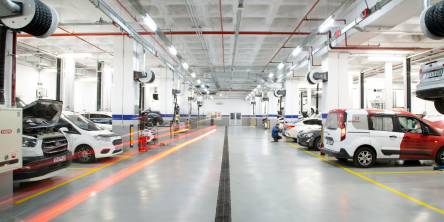How to Avoid Buying a Lemon Car?

Buying a trouble-free used vehicle has everything to do with good research and applying investigative expertise. The Buyer must also have the skills to spot out the potential problems and determine the reliability of a used car so as to avoid the expensive automotive cost down the road.
Here are some tips that will help you to ascertain whether or not the second hand car, you are buying is trouble-prone:
Check the vehicle’s reliability record
When you begin shopping for a vehicle, the best way to avoid buying a vehicle with potential troubles is to choose models with a good reliability record. You can take help of Consumer Reports’ annual subscriber survey to narrow your choices to some of the most reliable models. To get a more detailed perspective about the performance of the models in 17 trouble-prone areas, you can also go through the reliability-history charts that comes with most of the Consumer Reports' automobiles profile.
Read the vehicle’s window sticker
The federal trade commission has made it compulsory for every auto seller or dealer to provide a buyer’s guide with every used automobile listed for sale. It is usually attached to the vehicle’s window and must contain specific essential details such as the percentage of repair cost the dealer is obliged to pay and whether the automobile is accompanied by a warranty or not.
If the buyer’s guide states that the automobile is backed up with a warranty, the dealer must provide the warranty. Also, if any, changes are to be made in the Buyer’s Guide they must be done with before the sale. However, if it says that the automobile will be sold “as is”, this means that the dealer is not responsible for the condition of the vehicle. So in case any problem arises after you have purchased it, you will be liable for the expenses. Most of the states do not allow the “as-is” sales of automobiles beyond a certain price.
Inspect the Car’s Exterior
You can start by having a good look at the automobile, look for dents and scratches, mismatched body panels or components, cracked lamp housings, chipped paint or windows. Also check that the gaps between the body panels are of a consistent width and lines up perfectly. A closer inspection can help you to reveal any over sprayed paint on the chrome, automobile’s wheel wells or rubber trims. You must also check for the presence of body filler with the help of a small magnet. If it doesn’t stick to the panel, the vehicle may have a filler under the paint. If the door, trunk or hood of the vehicle doesn’t close properly, then it is an evidence of the previous damage or repair work. Inconsistent welding around the doors, trunk and hoods also show the repair.
Inspect the Car’s Interior
A good look at the vehicle’s cabin may reveal most of the obvious problems, like cracks in dashboard, missing handles, knobs or buttons and sagging headliner. Seatbelt’s that are frayed or with melted fibres indicates a previous frontal impact above 15 mph--damaged safety belts should always be replaced. Sagging of the driver’s seat and premature wear and tear of pedals indicates that the automobile has a very high mileage. Discoloured or worn-out floor mats, intermittent electric issues or silt in the trunk may indicate that the automobile is flood damaged. An airbag warning light that stays lit shows that the bag has deployed and replaced in an improper manner.
Inspect under the hood
Make sure that the engine, battery and the radiator are completely grease-free and have very less or no corrosion. The hoses and belts must be undamaged and pliable. Also look for wet marks that can show oil or fluid leakage. The common signs of overheating and engine fire are melted tubes, wires or lines. Check that the fluids are clean and doesn’t leak as well as filled up to the mark, when the engine cools down. To check the oil level, pull the dipstick off its tube and reinsert it after cleaning. The oil level must be in between “full” and “add” marks. Typically, an engine oil is black or brown in color, based on when it was last changed.
If you see a thin or frothy oil similar to the color of a chocolate milk, it may indicate a blown head gasket or a badly damaged cylinder head. Always check the transmission fluid after the automobile has been driven for more than 10 minutes. The color of the transmission fluid must be red to light reddish brown. However, if you the color is black, dark brown or mustard color, it may point serious issues.
Inspect the Tyres
The tyres should be evenly worn-out across the tread’s width as well as on the left and right sides of the automobile. Over-inflated set of wheels that are excessive and frequently used tends to have more wear in the middle while tyres that are under-inflated tends to wear out more on the edges. If the vehicle has been driven roughly, then you may observe excessive wear on the outside shoulder near the sidewall of the tyres. This can also point out that the other components may have been also damaged because of aggressive driving. Tyres with uneven wear and tear along the circumference of the tread or cupped tires can point to problems with the brakes, steering and suspension. Most of the buyers install the cheap car tyres just before putting the vehicle on the sale, which can be hazardous for the regular drivers in this case.
Inspect the steering
Check if the car’s steering wheel is turning smoothly right and left and not making any clunking noise. Excessive noise may indicate a worn-out steering gear. If you are driving at normal speeds on flat or smooth road, the vehicle shouldn't require constant steering corrections or wander. However, a shaking steering can be easily rectified by wheel balancing or front-end alignment.
Inspect the Suspension
Inspect the auto’s suspension by pushing down hard 2 to 3 times on each fender and letting go. The vehicle must bounce softly at least once or twice. If you observe two or more severe bounces, it points to wear out or damaged shock absorbers. Also have a drive at a bumpy road at a speed of about 30 mph. If your automobile slams and bounces at a moderate speed, then it may have a damaged or worn suspension.
Inspect the Tailpipe
When you start the automobile and observe a puff of white smoke it can be the result of condensation. After the vehicle has warm up, black smoke is released which indicates a highly rich mixture of air and fuel because of dirty air filter, mass, air meter or a defective oxygen sensor.
Blue smoke points to oil burning, which is a bad sign and need expensive repairs. Billowing white smoke points to water to the combustion chamber, which is usually the result of a blown head gasket, a cracked block or a damaged cylinder head.
Step on the Gas
Does your vehicle’s engine rev excessively before it accelerates? This is a common indicator of worn-out or misadjusted clutch or a broken automatic transmission. It will cost you extremely expensive repairs. While accelerating the automobile, listen for the pings and knocks. As this indicates a bad ignition timing or overheating of the engine.
Look for TSBs & Recalls
Check for problems related to recalls service. The National Highway Traffic Safety Administration (NHTSA) lists all the official recalls. Also ask the seller for documents associated with recall service. If you are considering any recall work and it has not been performed. It should be done as quickly as possible. When the automaker informs the dealers about the recurring or common issues related to a model and how to rectify them, they do it via a report known as “Technical Service Bulletins” or "TSBs". So before you buy any automobile, check for the TSBs issue associated with it and if the seller has already performed the required repairs.
Look or the Vehicle’s History
Check out the vehicle history report from the reputed provider as it will alert you to all possible issues like odometer fraud, reveal flood, fire and damaged in an accident. It will also tell you, if there is a rebuilt title that has been issued for the automobile. You can access this information through the vehicle identification number (VIN) that is usually given at the top of the dashboard or near the driver's side roof pillar.
Visit your local auto mechanic
Make sure to get the machine inspected by a professional mechanic who have good knowledge of automotive diagnostic work, before you finally buy it. In addition to it, also ask the mechanic to put the automobile on a lift and check the undercarriage. Larger scratches and kinked structural parts in the fuel tank can point to a previous accident. If you see a welding on the frame, it indicates that it might have been cut out or replaced during repairs. Also ask the mechanic to look for fresh undercoating, which can be used to hide any recent repair in the automobile’s structure.
Finally, no matter whether you are buying or selling a car for cash, these tips will help you to understand the whole trading process.
Similar Articles
Here's something worth thinking about: picking a car shouldn't feel like rolling dice with the people you love most. Thousands of families grapple with this exact dilemma every single year.
Before you lease a car, you need to understand lease agreements, research the market, and be aware of the ways some car leasing companies may try to manipulate you.
Learn how to safely remove your Jeep hardtop alone. Follow step-by-step tips, use the right tools, and enjoy open-air adventures with confidence.
When it comes to getting a new car, one of the biggest decisions you’ll face is whether to lease or buy. Both options have their pros and cons, but making the right choice depends on your financial goals, driving habits, and personal preferences
Find a reliable car shipping service with our guide! Learn about pricing, transport options, insurance, reviews, and support to make a safe, informed choice.
Cars face different challenges as seasons change. The scorching summer sun can damage paint and interiors, while winter road salt corrodes metal components. Rain in spring and fall brings its own set of issues with moisture and organic debris.
Accessorizing your Chevy Malibu improves your driving experience with practical benefits. The global car accessories market, worth over $442 billion in 2023, is projected to expand significantly, showcasing a robust movement toward vehicle customization.
Regardless of the age, the car can be maintained in decent condition both by the hands of professionals (whom the conditions and means allow) and by one's own efforts. Taking care of the car will not only allow you to maintain an attractive appearance but also reduce the costs of its maintenance
Discover stress-free travel with black car services! Enjoy luxury, punctuality, and personalized comfort for a seamless day of exploration and relaxation.









